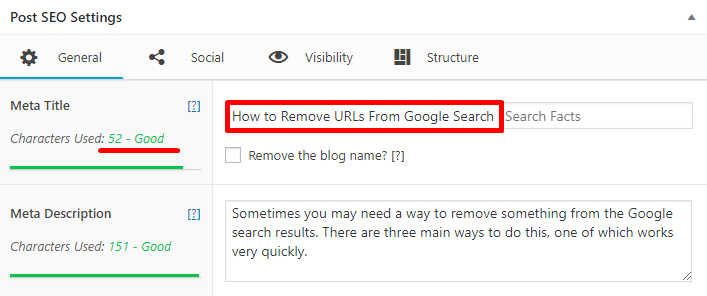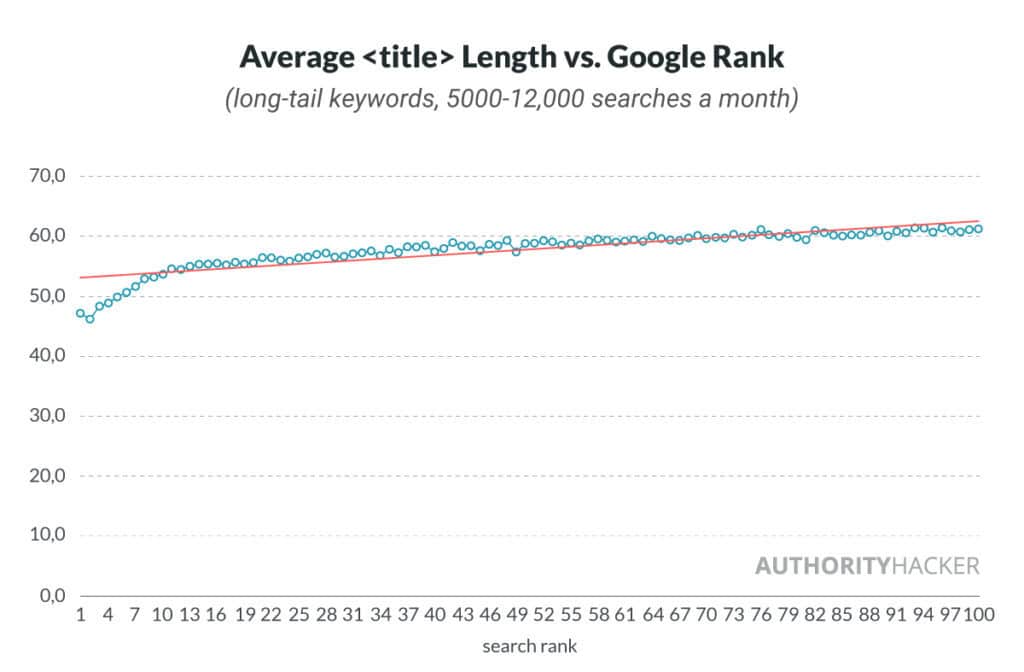The meta title tag is an HTML code tag that tells search engines and web browsers what the title of a web page is.
It looks like this inside the HTML code:
<title>This is the title of a web page</title>Writing effective title tags is a crucial skill in search engine optimization (SEO) and online marketing.
What is the meta title tag?
In web development, “meta” tags are code tags that provide data about web pages but aren’t visible on the pages themselves.
The meta title tag tells search engines, web browsers, and social media websites what the title of a web page is. It is supposed to be an accurate description of the content found on the web page.
Most importantly, the meta title shows in your page’s listing in an online search result.
Each standard search result has three things: 1. Title (the meta title), 2. URL, 3. Description (the meta description).

Having clear and descriptive titles that include keywords is very important if you want to get organic search traffic.
Just like the meta title provides the title of a web page, the meta description provides the description of the page.
How to view the meta title tag
Here are two quick ways to view the meta title tag of any website.
1. Hover over the browser tab
When you have an open browser tab, you can hover over the tab to see the meta title of the web page.

2. Check the source code
Most browsers allow you to check the HTML source code of web pages. In Chrome, you right-click on a page and click “View page source.”
Inside the source code, look for the <title> tag to find the meta title.

How to add a meta title to a web page
It is simple to add a meta title tag to most web pages.
If you are editing the HTML code directly, then you insert the tag between the opening and closing <head> tags.
Here’s what it looks like, along with the meta description:
<head>
<title>This is the meta title tag. It can be 45-60 characters long</title>
<meta name="description" content="This is the meta description. The maximum length is somewhere around 150-160 characters, but Google often pulls a description from your page content." />
</head>In WordPress
When you set the headline of a WordPress post, this will generally become the meta title tag.

This headline will show as the meta title tag, the main headline of the post (h1), and also the title when you share the post on social media.
However, if you have an SEO plugin like Yoast or The SEO Framework, then you can set a meta title that is separate from your article’s headline.
These SEO plugins will also help you optimize the length of your titles so that they don’t get cut off when they show up in the search results.
Here’s how it looks in the SEO Framework plugin:

These SEO plugins can also help you set separate titles for your page when it is shared on Facebook and Twitter.
How to write effective meta title tags for SEO
The meta title tag is so important for SEO that many people call it the “SEO title.”
The title is the most prominent feature of your site’s listing on the search engine results page (SERP). It is the main thing that search engine visitors look at before deciding which page to click.

For this reason, well-optimized title tags are among the most critical parts of on-page SEO, a type of SEO that happens on the web page itself.
If you have great titles, people are more likely to click on your site, and you are likely to rank higher. This drives increased traffic and helps your site grow faster.
Below are 7 SEO best practices to keep in mind when writing effective titles.
1. Include keywords in a natural way
Including keywords on a page is an important on-page SEO factor.
The most important place to include the keywords is the meta title tag.
When you include keywords in the title, it helps both search engines and your users to understand what the web page is about.
Some people recommend keeping the main keywords close to the start of the title tag. However, I don’t think this makes a big difference as long as the main keyword is prominent.
You should add the keywords in a natural way that is both descriptive and interesting. Importantly, you should never “keyword stuff” your title tags.
Including the exact match of the keywords isn’t even necessary, because synonyms can be just as effective.
For example, Google understands that “is green tea healthy” means the same as “is green tea good for you” and is closely related to “green tea benefits.”
Write your titles for humans, not search engine robots. The search engines (especially Google) are very good at understanding natural language.
2. Make it relevant, considering the intent of the searcher
You should consider the intent of the people searching on Google when writing your titles.
Then you should try to craft your titles in a way that makes people see that your content is relevant to the thing they are searching for.
When targeting the keyword “boiled egg,” then you probably would not rank unless your article is about boiled egg recipes or instructions on how to boil eggs.
That’s because most people who search for “boiled egg” are looking for those things. An article about the nutrition content of boiled eggs would have a tough time ranking for this query.
You can often get an idea of the search intent for a keyword by Googling the keyword yourself.
The types of articles that are ranking can give you a good idea of the kind of content that Google sees as fulfilling the intent of the search query.
Another reason to keep the titles relevant is that Google will be less likely to show a different title. Sometimes they pick something completely different than what is in your title tag if they don’t think it is relevant.
3. Aim for 45-55 characters
The optimal length of title tags is a moving target, but it’s important to consider because too long titles get cut off with an ellipsis (…) at the end.
Not only can the optimal length vary based on the searcher’s device, but Google is also frequently experimenting with it.
For example, in 2019, they did some experiments with a bigger font in the search results, which caused many title tags to be cut off.
That said, the optimal length is often considered to be about 50-60 characters even though some titles can be as long as 80 characters in total.
If the title is too long, it gets cut off. Sometimes Google also adds your site’s name to the end of the title, causing the actual content of your title to get cut off.
The characters you use in your title also matter because they vary in width. Google uses pixel width instead of character count to determine the cut-off point.
As long as your title is less than 600px wide, then it should display fully in most cases.
According to a recent 2019 study by Authority Hacker, they found that about 50 characters is optimal for SEO rankings.

For this reason, it makes sense to aim for a title in the range of 45-55 characters. But anything under 60 is usually fine, too.
Most SEO plugins help you optimize the length of your title tags and give you a warning if it’s too long or short.
4. Interesting, but not misleading
Your title tags need to be interesting so that people want to click on them.
However, they should still accurately describe the content on the web page.
Google (and users) hate clickbait and misleading titles. Their quality guidelines say that this alone can suffice to rate a website as low-quality.
Here’s a quote from Google’s Quality Rater Guidelines about misleading page titles:

5. Decide whether to include your brand name
It can be useful to include the name of your site at the end of the title tag. Many SEO plugins add it by default.
I usually remove this and let Google decide when to add it in. If the title is short, then Google often adds the site name to the search snippet.
For example, Google automatically added my site name to the snippet below:

If you have a well-known brand, then it makes a lot of sense to include your brand or website name at the end of every title.
6. Have a unique title on each page
Every single page on your website should have a unique title.
If pages have duplicate titles, then search engines won’t know which version to show. That could hurt your traffic.
7. Consider having your title different from your h1
Some people consider it to be better for SEO to have an h1 headline that is different than the meta title tag. You can do this with most good SEO plugins.
That said, I don’t think this makes a big difference for SEO. Many of my highest ranking articles have had identical titles and headlines.
Examples of good titles
Below are examples of excellent title tags that have helped pages rank for some of the most competitive terms online.
1. “Green tea”

This article has dominated the #1 result for its keywords (“green tea” and “green tea benefits” for many years. It has received well over 10 million visits, mostly from Google.
It is a list post, which a lot of people prefer for certain types of topics. It also uses the keywords naturally and implies that the content is science-based.
2. “How to lose weight”

This post is one of the most successful content SEO articles in history. It has dominated the #1 search result for “how to lose weight” and “how to lose weight fast” for many years and received well over 50 million visits, mostly from Google.
I wrote this article for my old site Authority Nutrition (sold to Healthline in 2017).
The title perfectly fulfills people’s search intent. They want to lose weight, preferably quickly, and they want to find a simple plan to do it.
People also like to follow things that are supported by scientific evidence. It sets the article apart from more generic weight loss articles.
3. “SEO”

The beginner’s guide to SEO on Moz ranks #1 for the super high-competition keyword “SEO.”
People searching for short-tail keywords that have a big learning curve can often be targeted with “beginner’s guide” articles.
Takeaway
Writing great titles is one of the easiest things you can do for SEO. But it can also have a tremendous impact on your results.
Taking a bit of time to work on your title tags can provide a big “bang for your buck.”
You should consider the fact that your title is often the only chance you get to grab the attention of a person browsing the web or searching on Google.
What I do for every single article is write 5-20 versions of the title, then I pick the best one from that list.
Try to use several different formats and then give some thought to which one you think would resonate most with search engine visitors.